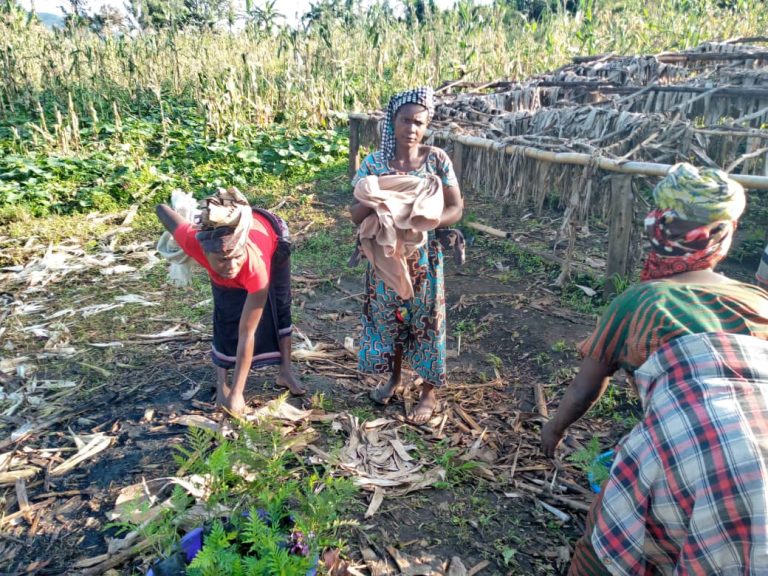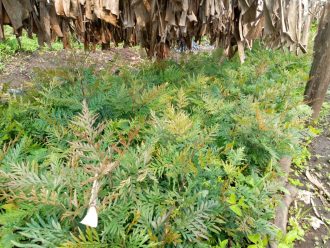Deforestation Around the Kahuzi-Biega National Park
30.10.2024
SUBMITTING ORGANIZATION
Imagine and Build the Congo of Tomorrow (ICCOD-NGO)
OTHER CONTRIBUTING ORGANIZATIONS
Call for the Cry of Congolese Women and Children (ACFE)
DATE OF SUBMISSION
9/9/2024
REGION
Africa
COUNTRY
Democratic Republic of Congo
KEYWORDS
Deforestation; environment
AUTHORS
Summary Sheet
The summary sheet for this case study is available here.
Introduction
Nowadays, all over the world we observe a problem of global warming, a tendency towards desertification of several environments following increased harassment of forests caused by the cutting of trees.
Regarding the province of South Kivu in general and the villages bordering the Kahuzi-Biega National Park in particular, which have welcomed refugee and internally displaced persons, the local population, the pygmies expelled from their natural environment which is the forest without any compensation has the following consequences: large-scale deforestation of trees in fields and forests causes several consequences such as climate change, the absence or lack and scarcity of rain which has become irregular, natural disasters caused by hurricanes, erosion and landslides of unprotected soils, soil infertility and its consequences famine and malnutrition, the disappearance of the environmental ecosystem which makes the environments unlivable and has consequences for all of humanity and thus accentuates the threat to the Kahuzi National Park. Biega which is a UNESCO world heritage site.
The territories and villages bordering the Kahuzi-Biega National Park are very mountainous. The arable land is very limited and has no fallow land.
The population is very high and to this is added the large number of displaced people from wars and armed conflicts.
This large population concentrated in the villages bordering the Kahuzi-Biega National Park faces difficulties in finding food, work and lives in great poverty. This state of affairs forces them to engage in destructive activities of the environment which include: cutting down trees for the production of members, boards for the manufacture of furniture and construction, gathering, hunting, illegal exploitation of minerals,
It should be noted that the forests of the villages in the Kalehe territory surrounding the Kahuzi-Biega National Park have recently been under heavy pressure due to the war between the M23 rebels in North Kivu, which has made the villages where the wood (embers, planks) used to come from inaccessible. The population of the city of Goma in North Kivu obtains this commodity from South Kivu, particularly in the Kalehe territory.
ICCOD-ONG through its environmental protection and rehabilitation program wanted to understand through a survey the «factors promoting environmental deterioration around the Kahuzi-Biega National Park in the Territories of Kalehe and Kabare in the Province of South Kivu/Democratic Republic of Congo”. This report presents a data analysis by cause and also presents local results. Local recommendations are also presented at the end of this report as collected in all villages taken as samples.
Methodology Used
The research was carried out by ICCOD-NGO through its Biodiversity Protection Program, it was carried out in two aspects: quantitative and qualitative.
The Kahuzi-Biega National Park borders four territories including Kabare, Kalehe , Shabunda and Walikale . The study was conducted in Kalehe and Kabare given that these two territories contain the largest number of riverside settlements of the Kahuzi-Biega National Park but also the limit of our means.
The first was the census and mapping of all the villages bordering the Kahuzi-Biega National Park in the surveyed territories. These are villages:
- Kalehe Territory : Katasomwa , Murangu , Lemera , Rwamikundu , Bitale , Musenyi , Miruwa , Cirimiro , Chigoma , Rambo, Chifunzi , Fendula , Mikonzi , Bitale.
- Kabare Territory: Muyange, Kamakombe, Chombo , Chivanga , Buyungule , Muyange , Chibati.
In the second aspect, the investigators developed a qualitative questionnaire on the factors affecting environmental degradation in the villages bordering the Kahuzi-Biega National Park in the two territories mentioned above.
The methods that were used here are: the focus group composed of at most 8 people and the interview took more or less 10 to 15 people per village as a sample and in each group, we collected the ideas or points of view of local leaders, men, women, young people, etc.
Since there are no precise official data within the scope of our study, we made the sample selection using quota and snowball methods.
Key people/community leaders were recommended by other respondents and attempts were made to survey women as well as men in these villages while recognising the limitations that may exist between genders.
A. First level data
Distribution of respondents by village:
|
Territory |
Villages |
Number of respondents |
||
|
Men |
Women |
Total |
||
|
Kabare |
Buyungule |
7 |
8 |
15 |
|
Kamakombe |
8 |
4 |
12 |
|
|
Muyange |
6 |
7 |
12 |
|
|
TChibati |
8 |
6 |
14 |
|
|
TChombo |
5 |
7 |
12 |
|
|
Kalehe |
Mikonzi |
8 |
7 |
15 |
|
Rambo |
7 |
7 |
14 |
|
|
TChifunzi |
9 |
5 |
14 |
|
|
Fendula |
8 |
3 |
11 |
|
|
Bitalé |
3 |
12 |
15 |
|
|
TChandji |
7 |
5 |
12 |
|
|
Kalongola |
5 |
6 |
11 |
|
|
TChirimiro |
13 |
5 |
18 |
|
|
TChigoma |
5 |
5 |
10 |
|
|
Murangu |
7 |
5 |
12 |
|
|
Mushunguti |
7 |
5 |
13 |
|
|
Katasomwa |
8 |
5 |
13 |
|
|
Lemera |
5 |
9 |
14 |
|
|
Miruwa |
6 |
7 |
13 |
|
|
Mulonge |
7 |
8 |
15 |
|
In all the 20 villages that our investigators visited, they spoke with 265 respondents, including 139 men and 126 women.
B. Second Level Data
In all the axes taken as a sample by the investigators, it is noted that in the use of wood as a source of energy, internal and external trade of boards, the poverty of the population, the low level of awareness, the illicit exploitation of minerals in certain villages,
- Energy sources: the strongest conclusion is the felling of trees which is the main factor for deforestation. Almost in all the axes where the survey was carried out, it was noted that the forest is under strong pressure which is explained by the use of embers and firewood in rural areas as the only source of energy but also urban areas use embers to a greater extent following the poverty of the majority of the population, the scarcity of other sources of energy because gas is not only expensive and the population does not have the culture to use it for fear of consequences related to the misuse of the latter. Since the national electricity company is installing the cas power system, the urban population hardly uses current to cook food considering that the electricity bill is expensive.
- Agriculture: after analysis of the data collected, it should be noted that agriculture contributes significantly to the deterioration of the environment through the methods used, which include: clearing, felling trees, incineration which often causes bush fires, etc.
- Hunting and abomasum: most animal-based foods come from livestock farming, as some people do not have the means or space to do this type of farming and are therefore dedicated to hunting which is a phenomenon by which some farmers use traditional tools to supply themselves with meat. However, given that the villages have almost no forests considered as community reserves; despite the efforts made by the Kahuzi-Biega National Park staff in the context of awareness raising and the fight against poaching, these hunters tend to go poaching in the park, thus threatening protected species or endangered animals.
- Illegal exploitation of minerals: according to the information collected during this study, minerals are exploited illegally in certain villages, this exploitation does not respect the rules of the art.
Recommendations
Considering the causes of environmental degradation mentioned above, the investigators and community members formulated the following recommendations to address environmental problems:
- Initiate reforestation projects to restore forests and raise awareness among populations about planting 5 trees if only one is felled;
- Promote agro pastoral activities to minimize poaching;
- Raise awareness among the population about environmental conservation measures;
- We ask the Congolese government to look into ways of compensating the indigenous Pygmy community who were expelled from the Kahuzi-Biega National Park when it was created and who are living without land or houses and in extreme poverty, forced to beg from the Bantu communities.
Today, the Bantu are threatening to return to the park by force if nothing is done, and some of their families have already settled there since 2021, without any solution from the government. Yet their presence here is destroying this area, which is known as a world heritage site, rather than protecting it. The ICCOD-NGO is sending out an SOS to our government and to international organisations concerned about environmental protection, asking them to buy land for this community in difficulty, which has long been forgotten, discriminated against, marginalised, stigmatised and forgotten.











